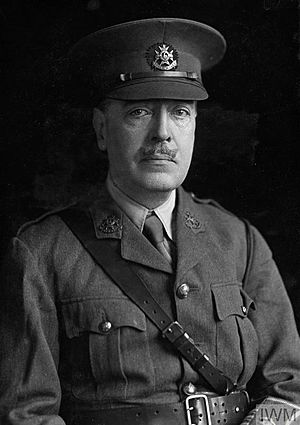Haldane MacFall facts for kids
Quick facts for kids
Haldane MacFall
|
|
|---|---|

Major Haldane MacFall c.1917 (IWM)
|
|
| Born | Chambers Haldane Cooke McFall 24 July 1860 Bengal, India |
| Died | 25 July 1928 (aged 68) London |
| Resting place | Highgate Cemetery |
| Occupation | Military officer, art critic, novelist, essayist and artist. |
| Nationality | British |
Haldane MacFall (born 1860, died 1928) was a British soldier. He also became a famous art critic and writer. He wrote many books about art history. He was also a novelist and essayist. He drew pictures for his own books. He also designed book covers for others. His art was even shown at the Royal Academy.
Contents
Early Life and Family
Haldane MacFall was born in India on July 24, 1860. His full name was Chambers Haldane Cooke MacFall. His father, David Chambers McFall, was an army doctor. He worked with a special army group in India.
Haldane's mother, Abigail Crawford, died when he and his younger brother, Albert, were small. The family moved back to England in the late 1860s. In 1870, Haldane's father married again. His new wife was Frances Elizabeth Bellenden Clarke. She was only sixteen at the time. She later became a successful writer known as Sarah Grand.
Like his father and grandfather, Haldane chose to join the army. He trained to be an officer at Sandhurst.
Army and Art Career
Haldane finished his training at Sandhurst. In 1885, he became a Second Lieutenant. He joined the West India Regiment in Jamaica. After serving in the West Indies, he fought with his regiment in West Africa.
It was in West Africa that he started his writing and art career. He wrote about his experiences for a magazine called The Graphic. He also drew pictures for the magazine. However, he caught a tropical disease in West Africa. This made him leave the army in 1890. He was a Lieutenant when he retired.
Haldane wanted to focus on his art. He lived in Paris in the early 1890s. Then he returned to England. He earned his living mainly as a writer.
In 1898, he moved in with his stepmother, Sarah Grand. She was living in Tunbridge Wells. She had left Haldane's father in 1890. She was also a successful writer.
Writing and Art Books
Haldane's first novel was called The Wooings of Jezebel Pettyfer. He set this story in Jamaica. It was unusual for the time because it had a West Indian hero. This book was published the year he moved in with Sarah.
His next novel, The Masterfolk, came out in 1903. It was a funny look at artistic life in London and Paris in the 1890s. In 1903, he also married Mabel Anne Plumridge.
Haldane kept writing for magazines. He combined his interest in art with reviews of art shows. His writings even caught the attention of the famous artist Whistler.
However, his main income came from his books about art. He wrote biographies of famous artists. Between 1903 and 1909, he wrote about Henrik Ibsen, Whistler, Henry Irving, François Boucher, Jean-Honoré Fragonard, and Élisabeth Vigée Le Brun. He also wrote several books about art movements. He created many illustrations and book covers.
During this time, Haldane worked with other artists. These included Henri Gaudier-Brzeska, who made a sculpture of him. Claud Lovat Fraser and Edward Gordon Craig drew pictures for his essay on art, The Splendid Wayfaring (1913). Haldane was also fluent in French.
Later Life and Legacy
Haldane was 54 years old when World War I began in 1914. He rejoined the army. He did not go to the front lines. But he was a very good officer. He was quickly promoted. He ended the war as a Major. He kept writing during the war. He published several books and essays about military topics.
His last book was published in 1928, the year he died. It was a strong defense of his friend, Aubrey Beardsley.
Haldane MacFall is buried with his wife Mabel. Their grave is on the eastern side of Highgate Cemetery in London.
Novels
- The Wooings of Jezebel Pettyfer (1898)
- The Masterfolk (1903)
- Rouge (1906)
- The Three Students (1926)
Images for kids

